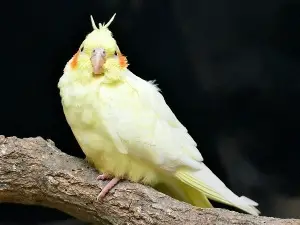
Some changes in your cockatiel are normal, and others are not and should be looked into.
If you’re wondering which category your bird is in and why there are stripes on your cockatiels beak then read on.
Table of Contents
Stripes on cockatiel beak:
Cockatiels are well-liked as pets because they are easy to breed and are easy birds to keep in captivity, you only have to make sure that the birds are healthy in your care.
If you’re keeping an eye on your bird, and you notice something strange in your bird, like the bird developing stripes on its beak you’d be right to be confused.
Here is why this may be happening:
Normal wear and tear:
One of the simplest reasons why your bird has stripes along its beak is normal wear and tear.
The outer layer of your bird’s beak is made up of keratin. Keratin is the same material that our hair and nails are made out of, this material can be damaged but it is forever growing
Your bird’s beak will suffer some wear and tear as the bird uses the beak, this can be from chewing, playing, etcetera. The stripes will be etched into the bird’s beak over time and this may be what you’re seeing.
What to do:
You don’t have to worry if this is happening, this is normal and as long as the bird isn’t in pain then the bird will be fine.
The keratin on the bird’s beak is always growing and flaking off, or being filed off, and the stripes indented in the bird’s beak will come off of the bird’s beak during this time.
The bird’s beak should go back to being smooth and stripe-free once the keratin layer has been filed or flaked off.
However, if the bird is showing signs of distress and its behavior is changing for the worse after the stripes appear then you need to take the bird to the vet for an examination and possibly treatment
Pied split:
If your bird has a stripe on its beak then the bird might be carrying the pied gene.
The pied gene can not only reduce the amount of melanin on a bird’s feathers, eyes, and feet, it can also reduce the amount of melanin on the bird’s beak
Cockatiel beaks are normally grey, the melanin in their beaks cause these birds to have grey beaks.
However, if the bird has some sort of mutation, if the bird has a pied split, then the bird’s beak can have a stripe on it that is yellow or white, this area contains no melanin.
The beak will be smooth and appear normal other than this trait.
Other signs of a pied bird include light patches in other parts of the bird’s body like under the wings, light feathers on the back of the head, light-colored toes and toenails, and even wingspots that look oblong.
What to do:
There isn’t anything wrong with your bird and this trait is not harmful to the bird in any way, its simply a trait that your bird has
If you enjoyed this article then you may also be interested in other bird related articles. Here are some articles that you may be interested in: Brown Spot On Budgies Beak, Black Spots On Cockatiel Beak, Red Spot On Budgies Beak, Black Spot On Parakeets Beak, Why Is My Ringnecks Beak Black?

